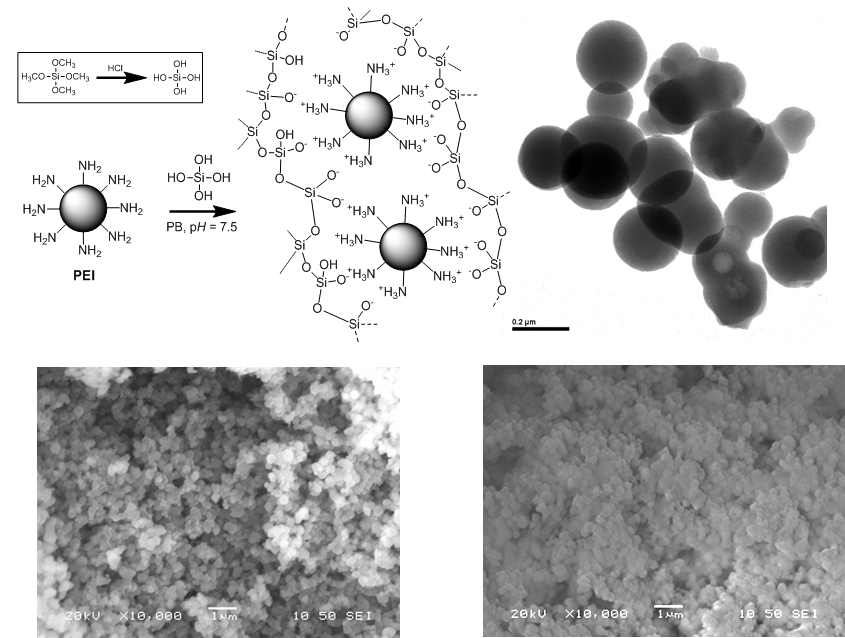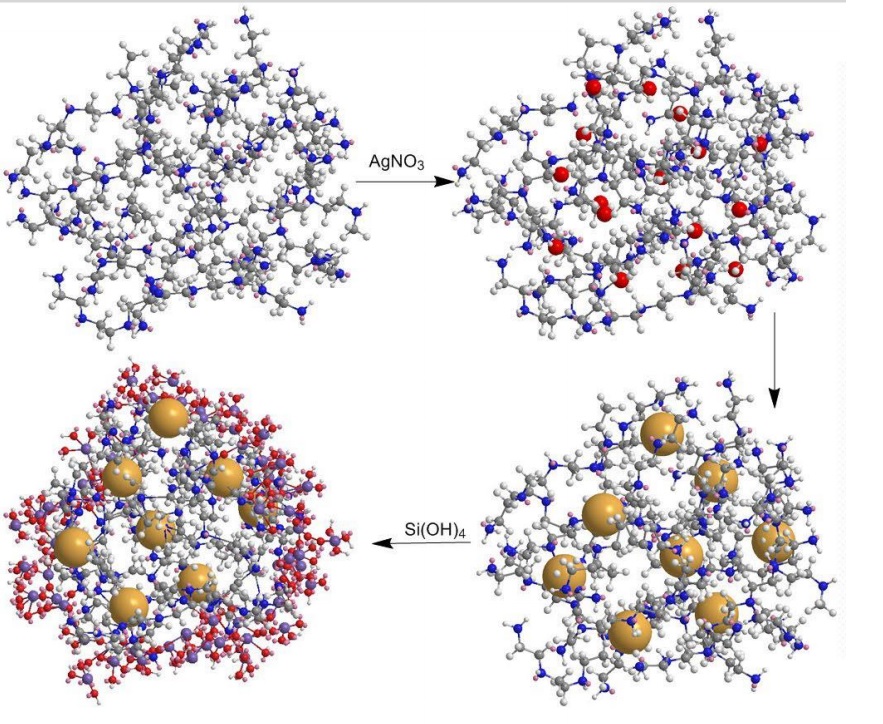Biomimetic synthesis of hybrid organic-inorganic nanoparticles
Environmentally friendly biomimetic synthesis of hybrid organic-inorganic nanoparticles
It is known that in marine organisms biogenic silica is formed rapidly in water under mild conditions through a process known as biosilicification, which proceeds at ambient temperatures, pressures and pH values, producing an amazing diversity of nanostructured frameworks. This is attributed to the presence of polycationic peptides called silafins that generate networks of silica nanospheres within seconds when added to a solution of silicic acid. This approach is adopted for the biomimetic synthesis of hybrid organic-inorganic nanoparticles. Indeed, silicon oxide (SiO2) nanoparticles can be prepared through a biomimetic silicification process in water at ambient conditions through the condensation of silicic acid in the presence of a small amount of low cost amino functionalized hyperbranched polymers.1-3

Expanding the above mineralization process in the field of biomimetic synthesis of various organic/inorganic nanoparticles controlled by polymeric hyperbranched matrices, our research activity was also focused on the development of complex polymer/alumina nanopowders with metal inclusions (Al2O3-Cu, Al2O3-Ni, Al2O3-Ce). A detailed study mainly of the particle size and shape as a function of pH during synthesis has been performed. These systems also formed the basis for the development of novel organo-silicate coatings or silicate based porous membranes for applications in catalysis.4 {insert link to project NEXT-GEN-CAT}
On a similar approach some organisms exploit primarily proteins and to a lesser extent other organic molecules for species-specific formation of metal nanoparticles. The mechanism for the reduction of metal ions to metals involves a number of enzymes, such as hydrogenase and NADH-dependent reductase. Thus, we initiated the investigation of two Bioinspired Reaction Mechanisms for the Production of Hybrid Nanomaterials from Dendritic Polymer Matrices5. The characterization of the resulting materials involves thermogravimetry, spectroscopy, ζ-potential, and scanning electron microscopy (SEM)/energy-dispersive X-ray spectroscopy (EDS). The obtained materials are applied as adsorbents, catalysts and for controlled drug delivery.

Relevant Publications
1. M. Arkas, D. Tsiourvas, Organic/inorganic hybrid nanospheres based on hyperbranched poly(ethylene imine) encapsulated into silica for the sorption of toxic metal ions and polycyclic aromatic hydrocarbons from water. J. Hazard. Mater. 2009, 170, 35–42.
2. D. Tsiourvas, A. Tsetsekou, A. Papavasiliou, M. Arkas, N. Boukos, A novel hybrid sol-gel method for the synthesis of highly porous silica employing hyperbranched poly(ethyleneimine) as a reactive template. Microporous and Mesoporous Materials 2013, 175, 59-66.
3. M. Arkas, Hybrid organoceramics deriving from dendritic polymers, methods of preparation, optimization techniques and prospected applications (Ed. Joan Josep Roa Rovira), Chapter 1, pp. 1-30 in “Recent Advances in Ceramic Materials Research”, 2013, Nova Science Publishers, New York.
4. A. Papavasiliou, D. Tsiourvas, E. G. Deze, S. K. Papageorgiou, F. K. Katsaros, E. Poulakis, C. J. Philippopoulos, N. Boukos, Q. Xin, P. Cool, Hyperbranched polyethyleneimine towards the development of homogeneous and highly porous CuO–CeO2–SiO2 catalytic materials, Chemical Engineering Journal, 2016, 300, 343–357.
5. M. Arkas, G. Kithreoti, N. Boukos, I. Kitsou, F. Petrakli, K. Panagiotaki, Two completely different biomimetic reactions mediated by the same matrix producing inorganic/organic/inorganic hybrid nanoparticles. Nano-Structures & Nano-Objects 2018, 14, 138-148.